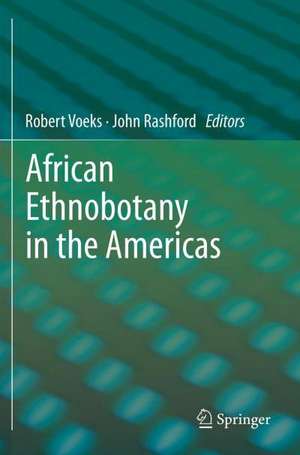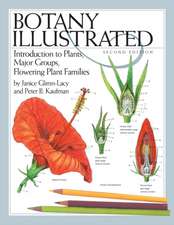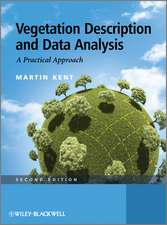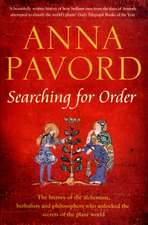African Ethnobotany in the Americas
Editat de Robert Voeks, John Rashforden Limba Engleză Paperback – 26 sep 2012
Bolstered by abundant visual content and contributions from renowned experts in the field, African Ethnobotany in the Americas is an invaluable resource for students, scientists, and researchers in the field of ethnobotany and African Diaspora studies.
Preț: 515.30 lei
Preț vechi: 606.24 lei
-15% Nou
Puncte Express: 773
Preț estimativ în valută:
98.62€ • 102.58$ • 81.41£
98.62€ • 102.58$ • 81.41£
Carte tipărită la comandă
Livrare economică 15-29 aprilie
Preluare comenzi: 021 569.72.76
Specificații
ISBN-13: 9781461408352
ISBN-10: 1461408350
Pagini: 332
Ilustrații: XII, 429 p. 105 illus., 69 illus. in color.
Dimensiuni: 155 x 235 x 20 mm
Greutate: 0.86 kg
Ediția:2013
Editura: Springer
Colecția Springer
Locul publicării:New York, NY, United States
ISBN-10: 1461408350
Pagini: 332
Ilustrații: XII, 429 p. 105 illus., 69 illus. in color.
Dimensiuni: 155 x 235 x 20 mm
Greutate: 0.86 kg
Ediția:2013
Editura: Springer
Colecția Springer
Locul publicării:New York, NY, United States
Public țintă
Professional/practitionerCuprins
Introduction.- Seeds of Memory: Botanical Legacies of the African Diaspora.- Did Enslaved Africans Spark South Carolina’s 18th-Century Rice Boom?.- African Origins of Sesame Cultivation in the Americas.- By the Rivers of Babylon: The Lowcountry Basket in Slavery and Freedom.- Gathering, Buying, and Growing Sweetgrass (Muhlenbergia sericea): Urbanization and Social Networking in the Sweetgrass Basket-Making Industry of Lowcountry South Carolina.- Marketing, Culture and Conservation Value of NTFPs: A Case Study of Afro-Ecuadorian Use of Piquigua (Heteropsis ecuadorensis, Araceae).- Berimbau de Barriga: Musical Ethnobotany of the Afro-Brazilian Diaspora.- Trans-Atlantic Diaspora Ethnobotany: Legacies of West African and Iberian Mediterranean Migration in Central Cuba.- What Makes a Plant Magical? Symbolism and Sacred Herbs in Afro-Surinamese Winti Rituals.- Medicinal and Cooling Teas of Barbados.- Candomble's Cosmic Tree and Brazil's Ficus Species.- Exploring Biocultural Contexts: Comparative Woody Plant Knowledge of an Indigenous and Afro-American Maroon Community in Suriname, South America.- Ethnobotany of Brazil’s African Diaspora: The Role of Floristic Homogenization.
Recenzii
From the reviews:
“This fascinating book, written by inquisitive authors, should be required reading for ethnoecological scholars. It documents the essential importance of African peoples and plants in the Americas through fruitful methodological syntheses of ethnobotanical and ethnoecological approaches, both diachronic and synchronic.” (Egleé L. Zent, Ethnobiology Letters, Vol. 4, October, 2013)
“A rich and exciting volume that joins a burgeoning effort to widen the ethnobotanical gaze, embracing the dynamisms of diaspora, migration, and disturbance. … volume will find great utility among scholars of ethnobotany, per se, but most any reader interested in the human–environment interface will find value in its clear prose and probing of historical discussions. The volume will make an effective course reader for undergraduates in geography, anthropology, and other disciplines, as it provides a compelling window into contemporary research methodologies and approaches.” (Case Watkins, The AAG Review of Books, Vol. 1 (4), 2013)
“This fascinating book, written by inquisitive authors, should be required reading for ethnoecological scholars. It documents the essential importance of African peoples and plants in the Americas through fruitful methodological syntheses of ethnobotanical and ethnoecological approaches, both diachronic and synchronic.” (Egleé L. Zent, Ethnobiology Letters, Vol. 4, October, 2013)
“A rich and exciting volume that joins a burgeoning effort to widen the ethnobotanical gaze, embracing the dynamisms of diaspora, migration, and disturbance. … volume will find great utility among scholars of ethnobotany, per se, but most any reader interested in the human–environment interface will find value in its clear prose and probing of historical discussions. The volume will make an effective course reader for undergraduates in geography, anthropology, and other disciplines, as it provides a compelling window into contemporary research methodologies and approaches.” (Case Watkins, The AAG Review of Books, Vol. 1 (4), 2013)
Textul de pe ultima copertă
African Ethnobotany in the Americas provides the first comprehensive examination of ethnobotanical knowledge and skills among the African Diaspora in the Americas. Leading scholars on the subject explore the complex relationship between plant use and meaning among the descendants of Africans in the New World. With the aid of archival and field research carried out in North America, South America, and the Caribbean, contributors explore the historical, environmental, and political-ecological factors that facilitated/hindered transatlantic ethnobotanical diffusion; the role of Africans as active agents of plant and plant knowledge transfer during the period of plantation slavery in the Americas; the significance of cultural resistance in refining and redefining plant-based traditions; the principal categories of plant use that resulted; the exchange of knowledge among Amerindian, European and other African peoples; and the changing significance of African-American ethnobotanical traditions in the 21st century.
Bolstered by abundant visual content and contributions from renowned experts in the field, African Ethnobotany in the Americas is an invaluable resource for students, scientists, and researchers in the field of ethnobotany and African Diaspora studies.
Bolstered by abundant visual content and contributions from renowned experts in the field, African Ethnobotany in the Americas is an invaluable resource for students, scientists, and researchers in the field of ethnobotany and African Diaspora studies.
Caracteristici
First in-depth study of ethnobotanical knowledge and skills among the African Diaspora in the Americas Includes original archival and field work Comprehensive visual content, including approximately 105 illustrations and photographs











